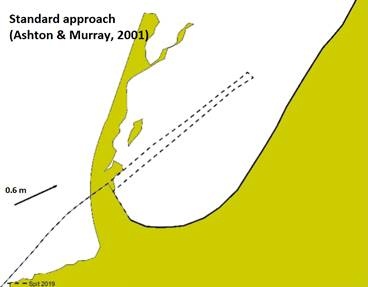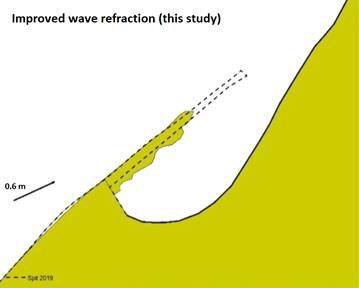| Panel |
|---|
A case study of Lobito, Angola |
In the field of coastal engineering computational models are a commonly used tool to gain insight in dynamics of a coastal system, to gain insight in or hindcast the historical development or can be used as engineering tool to assess the efficiency and consequences of a proposed coastal measure. A new coastline model, called ShorelineS, is under development which promises to be applicable for long term simulations on geometric complex coastlines or unstable beach regimes where, for example, spit formation may arise. This new model aims to overcome the gap between existing relatively simple coastline models and more advanced coastal area models. In this thesis the applicability of this new model on spit formation was assessed. A study case in Lobito (Angola), were a natural spit has formed, was used for this purpose. Three research objectives are of interest in this thesis: 1) getting insight in the relevant processes regarding spit formation (in general and for the Lobito spit) 2) validate the longshore sediment transport module of ShorelineS and 3) asses (and improve) the spit formation in ShorelineS. An inventory of existing spit formations around the world and a detailed modelling study (XBeach) on the transport rates around a spit showed that especially the bimodality of the wave climate is an important process influencing the final shape of the spit. Regarding the calculation of the longshore sediment transport it was found that for the modelling of the wave transformation a distinction should be made between the static fixed offshore depth contours and the dynamically changing nearshore depth contours for changing coastline orientations. This distinction is essential to consistently and correctly determine the breaking wave parameters which directly influences the longshore sediment transport calculations. This distinction was implemented in ShorelineS using the concept of a so called ‘dynamic boundary’. The spit formation in ShorelineS was assessed by means of hindcasting the historical spit formation of the Lobito spit using the ShorelineS model. Continuing on the previous finding it was found that the coastal orientation for which the longshore transport is maximum, which reflects the direction in which a spit migrates, should be derived on the actual, spatial and temporal variating, transport curves. This in contrast to the theoretical fixed angle as suggested by Ashton et al. which was previously used in ShorelineS. Both the implementation of the dynamic boundary and the routine to find the actual (variable) angle of maximum transport were needed to be able to correctly hindcast the observed spit formation.  Image Added Image Added Image Added Image Added
With the current, underlying, model assumptions it is not possible to correctly model the local decay of longshore sediment transport along the head of the spit. The width and local shape of the spit is therefore controlled by the so called ‘upwind correction’ routine in ShorelineS. This routine was updated to prevent the grid resolution dependency which originally directly controlled (forced) the resulting spit width. With this updated routine the spit width is based on an average (expected) spit width. This new routine should be considered as a proof-of-concept, further research is required to further develop this routine and find ways to include some kind of feedback mechanism in the model between the forcing, shape and the resulting LST over the head of the spit.
The full thesis can be found on the TU Delft Education Repository: https://repository.tudelft.nl/islandora/object/uuid%3Ab5845e73-c410-4145-8b1b-cad843d9a107?collection=education
|